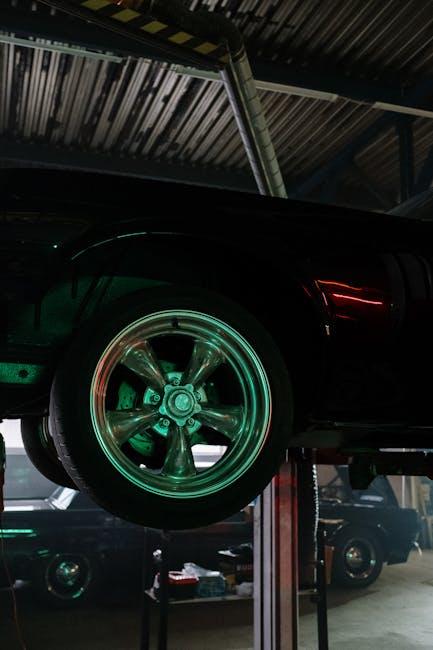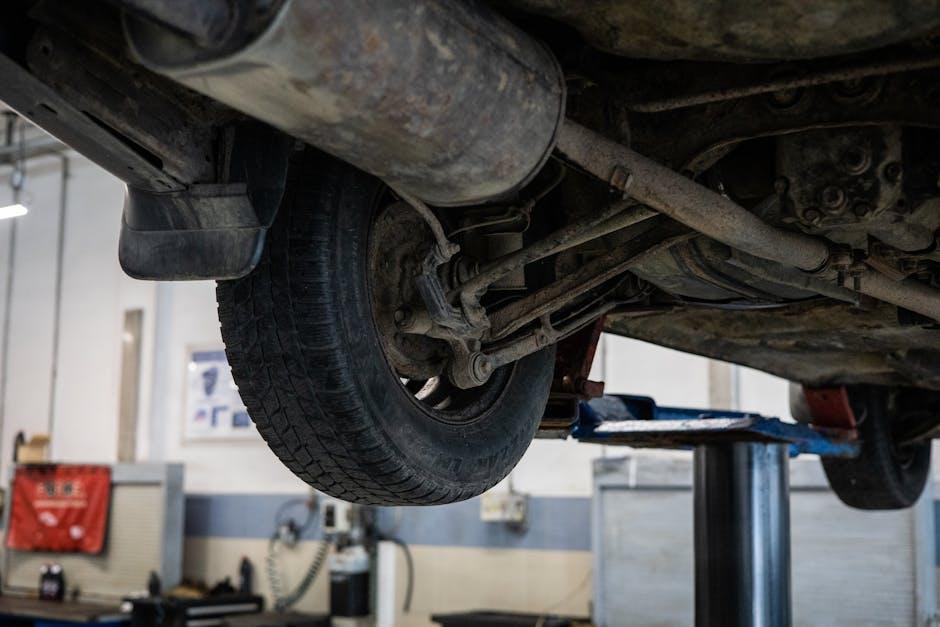Your vehicle’s suspension silently bears the burden of every bump, curve, and mile traveled, ensuring a smooth and safe journey. But just like a trusted dancer needs perfect balance, your suspension system demands precise alignment to perform at its best. When those delicate angles fall out of sync, the result can be uneven tire wear, shaky steering, or a compromised ride. So, how do you know when your suspension is calling out for an alignment check? In this article, we’ll explore the telltale signs and the right moments to bring your vehicle back into harmonious balance.
Table of Contents
- Signs Your Suspension is Out of Alignment and What to Watch For
- How Uneven Tire Wear Reflects Suspension Alignment Issues
- The Impact of Poor Alignment on Vehicle Handling and Safety
- When to Schedule a Suspension Alignment Check Based on Driving Conditions
- The Role of Suspension Alignment in Extending Tire Life and Performance
- Professional Inspection Tips for Accurate Suspension Alignment Diagnosis
- Q&A
- In Conclusion

Signs Your Suspension is Out of Alignment and What to Watch For
When your vehicle’s suspension starts to stray from its proper alignment, it often shows subtle signs that can easily be overlooked. One of the most common indicators is your steering wheel pulling to one side, even on a flat, straight road. This can make driving more taxing and unsafe. Additionally, uneven or accelerated tire wear often points to misaligned suspension components. Pay attention if you notice vibrations or a shaky steering wheel while driving, as this hints at uneven tire contact with the road surface, which could mean your suspension angles are off.
Be vigilant of the following symptoms that suggest it’s time to check your suspension alignment:
- Uneven tire tread wear – tires wearing more on one edge than the other
- Vehicle pulling left or right – difficulty maintaining a straight path
- Steering wheel off-center – when driving straight, the wheel isn’t level
- Unusual noises – clunking or squeaking sounds when turning
- Reduced handling and stability – feeling loose or less responsive driving experience
| Symptom | What It Means | What to Do |
|---|---|---|
| Pulling to one side | Misaligned toe angle | Get a professional alignment check |
| Uneven tire wear | Incorrect camber or toe setting | Replace tires and realign suspension |
| Off-center steering wheel | Faulty steering alignment | Adjust steering angle |
| Steering vibration | Suspension or wheel imbalance | Inspect suspension parts and balance wheels |

How Uneven Tire Wear Reflects Suspension Alignment Issues
When your tires start showing patches of wear that don’t match up across the tread, it’s a clear signal that something isn’t quite right beneath your vehicle. Suspension alignment issues can cause tires to rub unevenly against the road, leading to one side wearing down faster than the other, or specific areas showing deeper grooves or bald spots. This uneven wear not only shortens the lifespan of your tires but also compromises your vehicle’s handling and fuel efficiency, turning routine drives into hazardous ventures.
Several factors contribute to this imbalance, often hidden in plain sight:
- Misaligned wheels: When wheels point outward or inward instead of straight ahead.
- Worn suspension components: Bushings, ball joints, and shocks that no longer hold your vehicle steady.
- Incorrect camber angles: Too much tilt in the wheels causes uneven pressure on tire edges.
| Symptom | Likely Cause | Impact |
|---|---|---|
| Inner tire tread wear | Negative camber | Reduced tire life |
| Outer tire tread wear | Positive camber or toe-out alignment | Poor straight-line stability |
| Feathered tire edges | Incorrect toe setting | Noisy tires, uneven wear |
Paying close attention to these signs and having your suspension system inspected promptly can save you from larger repair bills down the road and ensure every journey is secure and smooth.

The Impact of Poor Alignment on Vehicle Handling and Safety
When your vehicle’s suspension falls out of sync, you’re not just facing uneven tire wear—it’s a cascade of problems that directly influence your control and safety on the road. Poor alignment can cause your car to pull to one side, forcing you to battle the steering wheel just to keep a straight path. This subtle tug can escalate into strain on suspension components, which may degrade faster, leading to costly repairs and compromised stability during turns or emergency maneuvers.
Beyond the inconvenience, misaligned suspension jeopardizes key safety factors. Your tires might lose critical contact with the road surface, reducing traction and braking efficiency. This means longer stopping distances and unpredictable handling, especially in wet or slippery conditions. Watch out for these warning signs:
- Uneven tire wear patterns such as feathering or bald spots
- Steering wheel vibration or wobbling at higher speeds
- Vehicle drifting or pulling to one side
- Off-center steering wheel while driving straight
| Alignment Issue | Handling Effect | Safety Risk |
|---|---|---|
| Toe Misalignment | Steering instability | Uneven tire wear, poor road grip |
| Camber Deviation | Difficulty turning & cornering | Increased risk of blowouts |
| Incorrect Caster Angle | Poor directional control | Reduced straight-line stability |

When to Schedule a Suspension Alignment Check Based on Driving Conditions
Understanding the right moments to book a suspension alignment check can save you from costly repairs and ensure a smooth, safe ride. If your daily travels involve rough terrain, such as unpaved roads, potholes, or frequent curbs, it’s wise to schedule an alignment check more often than usual. Heavy rain, snow, and frequent sharp turns also place extra strain on your vehicle’s suspension system, accelerating wear and tear. After any incident where the suspension or tires may have taken a hard hit—like hitting a major pothole or curb—it’s a smart idea to get an alignment inspection without delay.
For drivers experiencing symptoms such as uneven tire wear, the car pulling to one side, or a shaky steering wheel, an immediate suspension alignment check is essential. Moreover, regular maintenance intervals can serve as a good guideline, especially if you primarily drive in urban environments on smooth roads. Consider this handy table to gauge when an alignment check is due based on typical driving conditions:
| Driving Condition | Recommended Alignment Check Frequency |
|---|---|
| Urban, smooth roads | Every 12,000 miles or annually |
| Mixed road surfaces with occasional potholes | Every 6,000 to 8,000 miles |
| Rough terrains and off-road driving | Every 3,000 to 5,000 miles |
| Severe weather conditions (rain, snow) | After each harsh season |

The Role of Suspension Alignment in Extending Tire Life and Performance
Proper suspension alignment is more than just a routine maintenance step; it’s a critical factor that directly influences how your tires wear and perform. When your wheels are out of alignment, the tires don’t sit squarely on the road, leading to uneven tread wear. This not only shortens the lifespan of your tires but also compromises traction, leading to reduced handling and stability. Misalignment forces your tires to work harder on certain sections, accelerating wear patterns such as feathering or cupping, which can ultimately cause premature tire failure.
By ensuring your suspension is correctly aligned, you benefit from:
- Improved fuel efficiency—correctly aligned tires reduce rolling resistance.
- Smoother ride—wheel alignment prevents vibrations caused by uneven tire contact.
- Enhanced safety—better contact with the road surface increases control under various driving conditions.
| Symptom | Impact on Tire |
|---|---|
| Pulling to one side | Uneven inner or outer tread wear |
| Steering wheel off-center | One-side wear, faster tread degradation |
| Vibration in steering | Irregular tread pattern and premature wear |

Professional Inspection Tips for Accurate Suspension Alignment Diagnosis
To ensure a precise diagnosis of your vehicle’s suspension alignment, start with a comprehensive visual inspection. Look for signs of uneven tire wear, loose or damaged components, and any visible misalignment of the wheels. Use a tape measure to confirm wheelbase consistency on both sides and check the steering wheel’s centering during a straight drive test. Pay special attention to the camber, toe, and caster angles, as deviations in these can drastically affect handling and tire longevity.
Next, employ essential diagnostic tools like alignment gauges and computerized wheel alignment machines for accuracy beyond the naked eye. Regularly calibrate these tools for reliable data. Here’s a quick checklist to streamline your inspection process:
- Check tire pressures and inflate to manufacturer specifications.
- Inspect suspension components for wear and tear.
- Measure wheel offset and track width symmetry.
- Record steering angles during different driving conditions.
| Alignment Parameter | Ideal Range | Common Symptoms |
|---|---|---|
| Camber | -0.5° to +0.5° | Uneven tire wear, pulling to one side |
| Toe | 0° to 0.15° (in or out) | Scrubbing noise, tire chatter |
| Caster | 3° to 5° | Steering instability, wandering |
Q&A
Q: What exactly does suspension alignment mean?
A: Suspension alignment refers to adjusting the angles of your car’s wheels so they are set to the manufacturer’s specifications. This ensures your vehicle drives straight, handles properly, and wear on tires is even.
Q: Why is suspension alignment important?
A: Proper alignment keeps your car stable on the road, improves fuel efficiency, prevents uneven tire wear, and enhances overall safety.
Q: When should you suspect your suspension needs alignment?
A: If your vehicle pulls to one side when driving straight, your steering wheel is off-center, or you notice uneven or rapid tire wear, it’s a good sign your suspension might need alignment.
Q: Can hitting potholes or curbs affect your suspension alignment?
A: Absolutely. Impact with potholes, curbs, or rough surfaces can jolt your suspension out of alignment, so it’s wise to get it checked if you experience a hard hit.
Q: How often should you get a suspension alignment check?
A: As a rule of thumb, check your alignment once a year, or every 12,000 miles. However, if you notice driving issues or after suspension repairs, an immediate check is recommended.
Q: Is suspension alignment different from balancing tires?
A: Yes. Alignment adjusts wheel angles, while balancing ensures tires and wheels rotate evenly at high speeds. Both contribute to smooth driving but address different issues.
Q: What happens if you ignore alignment issues?
A: Ignoring alignment can lead to faster tire wear, decreased fuel efficiency, poor handling, and increased risk of accidents.
Q: Can I try to align my suspension myself?
A: Suspension alignment requires precise measurements and specialized equipment. It’s best left to professional mechanics to ensure accuracy and safety.
Q: Does alignment cost a lot?
A: Costs vary depending on the vehicle and location but generally, a standard alignment is affordable and well worth the preventive maintenance.
Q: In summary, when does your suspension need alignment?
A: Anytime you notice unusual vehicle behavior—pulling, uneven tires, off-center steering—or after physical impacts or suspension repairs, it’s time for a suspension alignment check. Regular maintenance keeps your ride smooth and safe.
In Conclusion
In the journey of maintaining your vehicle’s suspension, alignment plays a quiet but crucial role—ensuring each ride is smooth, safe, and steady. Recognizing when your suspension needs alignment can save you from uneven tire wear, poor handling, and unnecessary repairs. By tuning into the subtle signs your vehicle sends, you can keep your suspension in harmony and enjoy the confidence that comes with every drive. After all, just like a well-rehearsed orchestra, your suspension and alignment must perform in unison to deliver a flawless ride.
